Basque Country is one of the heartlands of cycling in Europe; it’s home to many cycling teams and clued-up fans. It also makes a fantastic place for a cycling holiday.
If you’re considering a Basque Country cycling trip, the first thing to know is where to find it on a map; and that has been a political issue for centuries! In short, Basque Country is a defined area of northern Spain. Bilbao and San Sebastian are its main two cities. However, wider Basque Country is less clearly defined and includes the region of Navarre in Spain as well as parts of France.
This article focuses on cycling Basque Country in southwest France – and in particular, the area around Saint Jean de Luz. Basque Country in France is not as well-known to cyclists as Basque Country in Spain, but it’s definitely worth knowing about!
Read on to find out more and get planning your cycling tour of Basque Country.
For more information on cycling in northern Spain, including Spanish Basque Country, read this article.
This article includes details of products and/or services that we have used ourselves or which we would consider using. Some are paid features or include affiliate links where if you click on a link and make a booking or buy something, we may earn a commission. As an Amazon Associate we earn from qualifying purchases. Please read our disclosure policy for further information.
All metrics in this article are approximate.
1. Where is Basque Country?
French Basque Country sits in the very southwest corner of France, at the foot of the Pyrenees and abutting the border with Spain. Bayonne and Biarritz are the major towns. Labourd, Basse Navarre and Soule are the three provinces.
As mentioned, the better-known part of Basque Country is the defined administrative region of Spain, just over the border from Basque Country in France. Here you find San Sebastian and Bilbao, two well-known hubs. The four Basque provinces in Spain are Navarra, Guipuzcoa, Biscaye and Alava.
Basques retain a strong identity and many locals view themselves as Basque first, French (or, as the case may be, Spanish) second.
2. What is cycling Basque Country in France like?
French Basque Country is relatively little known and somewhat underrated as a cycling destination. From sweeping coastal vistas to the lung-busting steep climbs through rural green landscapes, there is great variety. We found roads are generally quiet, drivers are patient and respectful, and the food is excellent!
Whether it’s the surf beaches of Biarritz or the charming, sheltered bay of Saint Jean de Luz, the region has great potential for a family holiday with options for the cyclist. There are a range of attractions, beaches and charming villages, with buildings everywhere immediately recognisable by the Basque red paintwork (more on that below).
 View over Saint Jean de Luz from the apartment we stayed in
View over Saint Jean de Luz from the apartment we stayed in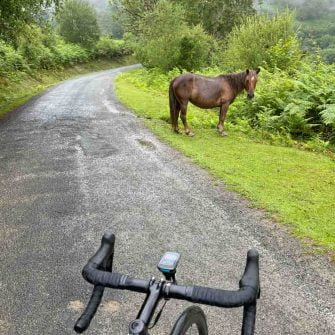 On the road in Basque Country
On the road in Basque CountryIn terms of the riding, French Basque Country has the variety to keep you amused for a good week of riding. If you wanted to do a multi-stop break, you could either hop over the border and into Basque Country in Spain or you could head a little further west into the Haute-Pyrenees region. There you’ll find the famous cols of the Tour de France, including the Tourmalet, Aspin and Hautacam. To give you an example of distances, it’s about 200 kilometres from Saint-Jean-de-Luz to Argelès-Gazost, one of the great bases for the climbs of the Pyrenees. You can read our guide to the Pyrenees here.
Compared to other cycling destinations around this latitude, the French Basque Country can be incredibly lush and green. Often the country roads are densely forested, which can make for pleasant shady riding, but with less expansive views than elsewhere. This greenery does not happen by accident, of course, and our experience is that rain can be relatively frequent and heavy! But it would be a shame for this to put you off what is a fantastic part of France to ride a bike, where the climate is warm and road surfaces generally good.
3. What are the must-do cycling routes in Basque Country?
Below we share the routes we rode from Saint Jean de Luz. You’ll see a few of them straddle the border between France and Spain.
Introduction ride
This is a nice easy 29km ride to get your bearings, perhaps your first sortie when you arrive, a gentle recovery day, or if you’re pushed for time. From Saint-Jean-de-Luz, follow the front north and climb up the headland. This section is a cycle path that is paved though sometimes a little gravelly and busy with beachgoers, but fine if you’re not in a rush.
Past the buzzing Erromardie and Lafitenia beaches, you then cross over the A63 motorway for a first taste the lumpy country roads and lush green roadside vegetation of the French Basque region.
You skirt the village of Ahetze before dropping down to the D918, the main valley road. For an easy, fast finish you can follow this road all the way back to Saint-Jean-de-Luz. We recommend forking right on the D307 for a more rural route. After going back under the A63, the route takes you through quiet residential roads and through the charming historic centre of the town.
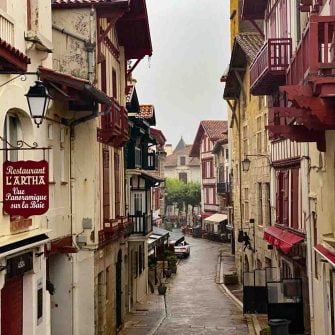 Saint Jean de Luz’s old town with classic Basque buildings
Saint Jean de Luz’s old town with classic Basque buildings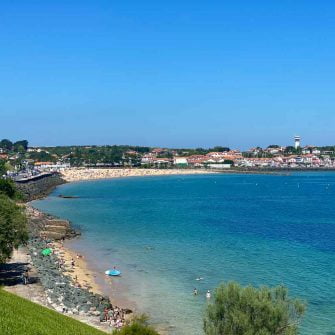 Basque Country coastline near Saint Jean de Luz in the sunshine
Basque Country coastline near Saint Jean de Luz in the sunshineAiako Harria Natural Park
For us, this challenging route gives you the best of everything the region has to offer. Roughly evenly split between France and Spain, you will experience sweeping coastal views, Basque villages and long steady climbs on deserted roads in the stunning Aiako Harria Natural Park. In certain parts, the forest and thick vegetation is so dense and lush that you could imagine yourself in a tropical jungle. While this limits the views, it certainly makes this region special.
The first 12 km leaves Saint-Jean-de-Luz on small lanes, after which you arrive at the typical Basque village of Ascain. From here, the D4 to Sare warms up your legs over the Col St Ignace (3.3km at 4.6% average), where you will see the tourist train of La Rhune.
 Bar Restaurant Hordago Ostatua at the Col de Lizarrieta
Bar Restaurant Hordago Ostatua at the Col de Lizarrieta Lush, dense forest roads before Etxalar
Lush, dense forest roads before EtxalarNext, it’s the small village of Istilarté. Then the road starts to climb for around 10km, first gradually, then more steeply over the Col de Lizarrieta. Here you have the option to refuel at the small restaurant before the twisty descent. At this point you cross to Spain and experience some rugged vistas before dropping into the valley and down the valley to Lesaka.
The next 8km are another solid block of climbing, before some brief respite down to the lake at Endara and another 3km of ascent. While the summit is nondescript, the achievement and natural beauty is reward enough, as is the 10-15km of largely downhill through Oiartzun to Errenteria, on the outskirts of San Sebastian. After navigating a few more busy kilometres, you traverse Lezo and soon find the final major climb of the day.
Pico Jaizkibel is a solid 8km of climbing with gradients varying between flat and 8% in true Basque fashion. In the second half, the coastal views open up as reward for your climbing efforts, with long range 180 degree views up and down the coastline that falls away to your left. The descent is equally captivating, with steep gradients and hairpins that demand your concentration.
After the descent, you work your way through the more industrial Irun in Spain and the seaside resort of Hendaye in France, before the final short climb on the coast road the follows the headland with distant views of the bay of Saint-Jean-de-Luz. Finally, the seaside port and fort of Socoa, before cruising happy, but tired, into the town.
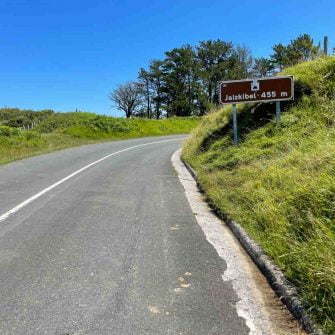 Summit of Pico Jaizkibel
Summit of Pico Jaizkibel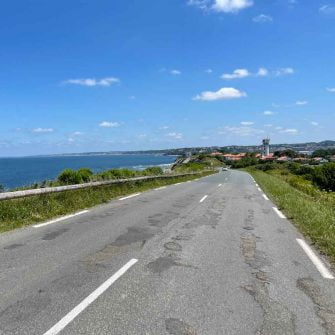 Views towards Hendaye
Views towards HendayeThe towns of French Basque Country
From Saint-Jean-de-Luz, this ride takes in the two largest towns in the French Basque Country: Bayonne and Biarritz.
From Saint-Jean-de-Luz, the route heads east into the rolling rural countryside, on small windy roads past farms and through Basque villages. Some of the roads can be a little gravelly, but you’re rewarded by a wonderfully quiet route in this sparsely populated area.
After the village of Herauritz, you descend a short, sharp hill to the river Nive, a tributary of the Adour that flows through Bayonne. A paved cycle path winds along the riverbank for a full 10km to Bayonne, with charming river scenery reminiscent of the fens of eastern England. The route takes you into the heart of Bayonne, with attractive, cobbled streets and attractive gothic cathedral.
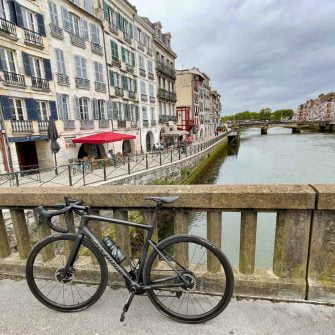 The river in Bayonne
The river in Bayonne Bayonne’s historical centre and cathedral
Bayonne’s historical centre and cathedralFrom Bayonne, you follow the banks of the Adour and onto the rugged Atlantic coastline of surf beaches, arriving quickly at Biarritz. Perhaps the most famous city in Basque country in France, acclaimed for its beaches, surf spots, golf courses, and gastronomy.
After a quick tour of the Biarritz coastline, with its crashing waves and crowds of surfers, the route winds south on D roads, with a detour to the beaches of Lafitenia and Erromardie, before returning to Saint-Jean-de-Luz.
 Biarritz city and the famous sand beaches, France
Biarritz city and the famous sand beaches, France Biarritz’s famous beach on a slightly gloomy day
Biarritz’s famous beach on a slightly gloomy dayThe villages of French Basque Country
This 65km route leaves the coastline behind and heads inland to explore some of the beautiful villages and roads of the French Basque region.
After crossing the Nivelle river (Urdazuri to the Basques) to Ciboure, you speed along the narrow valley road to charming river views to arrive in the village of Ascain, joining the D4 road and climbing the Col St Ignace (with the La Rhune tourist train at the summit) to descend to Sare. From here you continue on the D4, then left on the D20 at Dantxaria through a series of wonderfully Basque-sounding villages: Ainhoa, Amikueta, Karrika and Opalazi. A few short climbs work your lungs and legs, but the far-reaching views of the rolling hills and distant peaks provide ample distraction.
Next you reach the tourist mecca of Espelette, home of the famous pepper. A very attractive and typically Basque village, you can get a good coffee, meal or ice-cream. In peak season or those with an aversion to crowds, you may wish to pedal through to enjoy the scenery and stop in one of the less known villages.
The return towards Saint-Jean-de-Luz follows a relatively direct route through the village of Ibarrun. Back in Ascain, the route deviates west for a different, more rural return to Ciboure, with a few more lumps and bumps, a taste of tucked-away Basque houses, and the more wealthy outskirts of Ciboure.
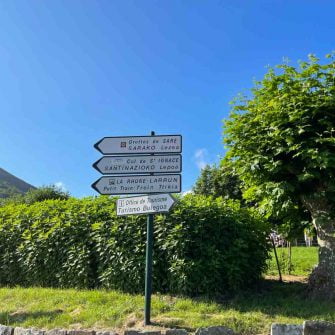 Ascain: an artisans’ village on the River Nivelle at the base of La Rhune mountain
Ascain: an artisans’ village on the River Nivelle at the base of La Rhune mountain Cayenne peppers at Espelette
Cayenne peppers at EspeletteCastillo del Inglés
This ride takes you to and from Saint-Jean-de-Luz to the Spanish town of Irun by contrasting routes, with an out-and-back up the challenging climb of Castillo del Inglés. This ride is one that provides both interest and challenge in a bitesize package.
The outbound route takes you along the scenic coastal road to Hendaye, crossing the border to Spain into Irun. The return leg cuts inland, tracing the Franco-Spanish border, before heading north on tiny rural country roads that sometimes weave alongside the concrete mass of the autoroute. The transition to the bustling, more populated coastline is stark, though both have their respective charm.
Castillo del Inglés is a tough climb averaging 11.5% for nearly 4km, with some brutally steep and typically Basque sections that are a contrast to the steady gradients that are more characteristic of the Alps. Forest and alpine meadows line the route, but typically the views are limited by the heavy vegetation.
You could make this into a (much) longer loop back into France or join up with the Aiako Harria Natural Park route in Oiartzun.
 Only an unmanned booth marks your ascent to the top of Castillo del Inglés…
Only an unmanned booth marks your ascent to the top of Castillo del Inglés… But the summit views provide your reward.
But the summit views provide your reward.4. What are the key road cycling events?
While the Tour of the Basque Country and Clasica San Sebastian are predominantly on the Spanish side of the border, the Tour de France does periodically visit Basque Country in France.
Looking ahead, Bilbao will host the Grand Départ of the 2023 Tour de France, with the opening days of the race expected to take place in the Basque Country on both sides of the border between France and Spain.
While the focus of this article is Basque Country in France, it’s worth a reminder that for 20 years, until 2013, Basque cycling had its own pro team representative in the form of the Euskadi and Euskaltel teams. The idea behind it was to promote the region and give local cyclists a chance to compete at the world level. The list of famous pro cyclists coming from Basque Country is long and includes names such as Mikel Landa, David Lopez and Haima Zubledia.
The legacy of this has been long and we’ve heard that the Tour of the Basque Country is well supported by locals who are passionate and knowledgeable about cycling. Parallels with the kind of cycling mad local you get at the Tour of Flanders are often drawn.
5. What’s the best place to stay?
France
Biarritz and Bayonne, the largest towns of the Basque Country in France, offer the best all-round facilities for cyclists, from the range of accommodation and gastronomy to bike shops.
For those that like a slightly more authentic experience (and certainly fewer international tourists) but still within a good-sized town, we wouldn’t hesitate to recommend Saint-Jean-de-Luz. With a protected bay, beautiful views and a buzzy atmosphere, Saint-Jean-de-Luz offers not just a wealth of options to the cyclist, but also the whole family.
It’s also a very picturesque town to base yourself in, with some fine Basque architecture, a harbour, pretty town square with shady trees and lots of boutique shops. There’s also a strong fishing tradition that continues today. Sardines are caught off the Portuguese and Moroccan coasts, anchovies in the Bay of Biscay and tuna off the French and African coasts.
 Plenty of small hotels and holiday houses in Saint Jean de Luz
Plenty of small hotels and holiday houses in Saint Jean de Luz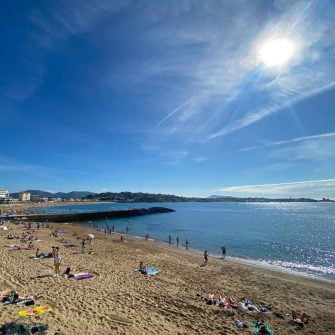 The sandy Grande Plage at Saint Jean de Luz
The sandy Grande Plage at Saint Jean de LuzSpain
If you want to base yourself in Spanish Basque Country, we had a fantastic (if wet) trip to San Sebastian a few years ago. San Sebastian is best known for its incredible food; pintxos are an art form here and there are more Michelin starred restaurants per square metre than any other city in the world (other than Kyoto in Japan). The cycling in and around San Sebastian isn’t bad either! Basque Country is the traditional home of cycling in Spain and is home to many famous manufacturers such as Orbea and BH.
That said, while Spanish Basque Country is probably more famous than French Basque Country, due perhaps to the regular visits by the Vuelta, we preferred riding from Saint-Jean-de-Luz than San Sebastian. It’s a smaller town, which makes getting in and out easier, and the countryside felt much more rural and undeveloped.
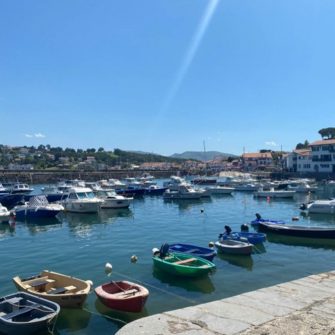 As well as the spectacular beach at Saint Jean de Luz, there’s also a pretty harbour
As well as the spectacular beach at Saint Jean de Luz, there’s also a pretty harbour La Concha beach in San Sebastian, Spain
La Concha beach in San Sebastian, Spain6. Are there any bike hire/bike shops in Basque Country, France?
We didn’t need to use a bike shop while in the area, but hopefully this list of Basque Country bike shops in the Bayonne/Saint Jean de Luz area would assist if you encountered a dreaded mechanical while away.
Atelier Bizikleta
12 Boulevard Thiers, 64500 Saint-Jean-de-Luz
09 54 60 94 09
Vélo Morisson Cycles
17, Avenue Marl Soult, Rn1064100, Bayonne
05 59 52 08 20
05 59 63 39 43
Culture Vélo Anglet
91 Rue Lamouly, 64600 Anglet
05 59 57 99 03
Vélo News 64
10 Avenue De Bayone, 64210 Bidart
05 59 41 06 33
Decathlon Hendaye
8, Rue Des Orangers, 64700 Hendaye
05 59 48 02 02
05 59 48 26 00
7. Any tips for cycling in Basque Country?
Practicalities
You could easily spend a week in this corner of Basque Country with a single base. A car will allow you greater flexibility for some day trips, perhaps inland to explore some of the famous climbs in the High Pyrenees or for trips into Spain. San Sebastian and Bilbao offer great options for day trips into Basque Country in Spain.
While the temperature is generally good for riding, if you’re cycling northern Spain/ this corner of southern France, be aware that rain can be heavy, frequent and unexpected! We would recommend carrying a rain jacket on all but the most sunny and clear days.
The surroundings (and one of the most attractive features of this region) are often very remote, with few services for bike repair and sporadic food and drink stops. We would urge you to be self-sufficient.
Drivers are generally unhurried and courteous, although we tend to find that drivers in France are more prone to close passes, higher speed and less awareness at junctions than in some other countries. Generally, the traffic is low in the French Basque Country, although as a popular summer destination, things can get busy accordingly.
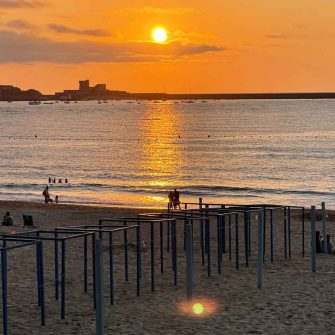 An incredible sunset at Saint Jean de Luz
An incredible sunset at Saint Jean de Luz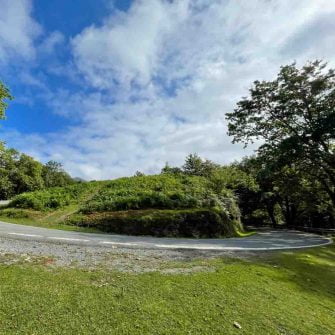 Eyes on the road! Sweeping hairpins and stunning Spanish views after the Col de Lizarrieta
Eyes on the road! Sweeping hairpins and stunning Spanish views after the Col de LizarrietaCulture
The food in Basque Country is excellent so it’s worth taking full advantage, with Bayonne, Biarritz and Saint-Jean-de-Luz providing the widest range of options. While the region’s wine is lesser known than many other French regions, it is well worth sampling! Don’t miss the Iroulegy red wine, Gateau Basque made with pastry and almond cream, fish soup, Bayonne ham and Manchego cheese.
Talking of the famous Bayonne ham, did you know it’s not made in Bayonne itself? The reason it acquired the name “Bayonne ham” is that it was shipped around the world from Bayonne port.
Expect to be confused by the language in this corner of France/Spain. The Basque language, Euskera, is a key part of the culture and has many unique words not found in French and Spanish. You’ll also see a good smattering of the letters H, X, K and Z in words. Expect to see local regions, towns and train stations to have different Basque language names too!
Interestingly, the Basque language is unique in the world and is one of the oldest of the European languages. Since Roman times, it was spoken all the way along the Pyrenees.
And finally, a note on the distinctive Basque architecture. You’ll immediately notice the white-washed buildings with their red or green timber frames and window shutters. This is not merely decorative. The half-timbered structure were both cheap and light to build, while the red and green represents the Basque national colours. You may also notice that the roofs are often longer on one side than the other. This is due to the practice of extending one wing once the family was sufficiently wealthy.
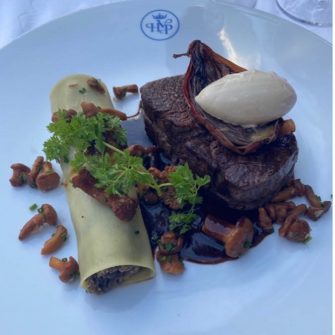 Expect delicious food in this corner of France (and Spain!)
Expect delicious food in this corner of France (and Spain!)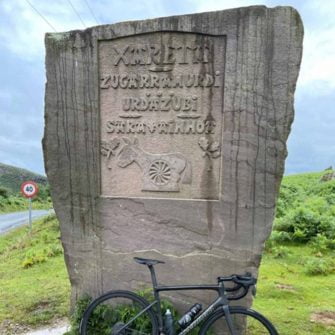 Tiny roads deep in rural Basque country, south of Zugarramurdi
Tiny roads deep in rural Basque country, south of ZugarramurdiBooks
If you’re looking for some extra reading on cycling the Basque Country, you might like Peter Cossins’ book, A cyclist’s guide to the Pyrenees, which has a small section with several routes on cycling the Pyrenees Atlantiques and Basque Country.
What’s next?
Tell us what you think of this article – comment below or drop us a line.
Want more? Don’t miss our guides to the French Pyrenees, including Argelès-Gazost and Bagnéres de Luchon. Our overview of cycling in the Pyrenees, mainland Spain and our article sharing our favourite regions of France for cyclists might also be useful.
Want to check out some other destinations? Search by the month you want to travel or cycling destination you want to visit, here.
Need tips for planning your own cycling routes? Check out our hugely in-depth cycle route planning article which contains all our tips.
Please support Epic Road Rides
A huge amount of time and effort goes into the article you’ve just read, all with the aim of helping you!
If you found what you’ve read useful, I’d really appreciate it if you dropped something in the tip jar here.
It’s a way you can say thank you and help us carry on creating top quality content with no annoying ads and no pay wall.
Looking for an organised cycling trip?
If you want someone to help you plan and book your cycling holiday, fill out this form. We aren’t a tour operator/agent but we work with lots of people who are and will do our best to put you in touch with someone that can help (within 24 hours wherever possible)!
The contents of this website are provided for general information purposes only. It is not intended to amount to advice and you should not rely on it. You should carry out your own due diligence and risk assessments and take professional advice. Views expressed by interviewees or other users of this website do not necessarily represent our views. We make no representations, warranties or guarantees, whether express or implied, that the content on our website is accurate, complete or up to date. If you use any information or content on this website, download from, or otherwise obtain content or services through our website, it is entirely at your own discretion and risk. Epic Road Rides Ltd disclaims all liability and responsibility arising from any reliance placed on the information and content on this website. Find out more here.



Thank you for this article! It’s so incredibly thorough. I will be traveling in San Sebastian and Saint-Jean-de-Luz in a few weeks from Los Angeles and am an avid cyclist. I didn’t know where to begin in my search of information but this article had it all. Thank you for the routes and I will be sure to explore some of them.
Hi Cristina, thanks so much for your kind words. I’d hugely appreciate it if you would consider leaving us a Google review (https://g.page/r/Cd84Ein4p9OoEAI/review)? They make all the difference and help others find us! And if you want to support our future work you can always buy us a coffee (https://ko-fi.com/epicroadrides) 🙂
Happy riding!
Clare